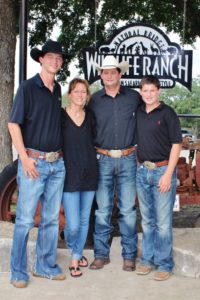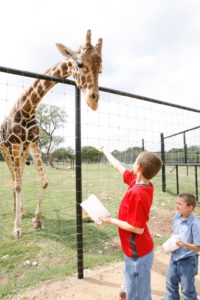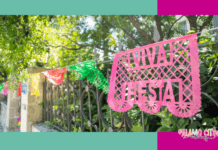Motherhood is never easy: the work is unending and, frankly, kids can be beasts. But can you imagine being mom to actual beasts? Or 500 of them? We’re talking real animals, not just when kids behave so badly it seems like they are animals. Tiffany Soechting, Marketing Director at Natural Bridge Wildlife Ranch and mother of two boys, serves as a human “mom” to the 500 animals that call the ranch home.
Tiffany has stepped in to mother everything from a wallaby to a giraffe, taking care of animals in need and working at NBWR as she’s raised her family. Remember all of the hype surrounding April the giraffe and her slow-to-arrive baby? Tiffany’s been there, done that—27 times. Yes, 27 giraffe calves have quietly gotten their start right here in San Antonio. But she is also mom to T. Dexter, 21, and Zane, 16, who grew up with those giraffes and assorted other wildlife.

If you’d like to learn more about giraffes, NatGeo Wild will air Mission Critical: Walking With Giraffes on Sunday, May 21 at 7:00 P.M. CST. The film includes footage from NBWR, including Buddy, a giraffe you’ll read more about below. To get a glimpse of Buddy (and Tiffany), check out the third portion of this sneak peek. To learn more about giraffe conservation, Buddy, and what Natural Bridge Wildlife Ranch is doing to help, visit here.
So what’s it like to mother a zoo? That’s exactly what we asked Tiffany, who graciously shared some insights on life at NBWR.
Q: What’s the history of NBWR? How did you get your start as an animal “mom”?
Working with animals is really all I ever wanted to do. I started working here (NBWR) 11 months after it opened, then went off to Texas Tech and earned my degree in animal science.
My husband and I started dating in high school, were at Texas Tech together, and worked here together. Most people don’t know that we’re family-owned. We don’t talk about it because as far as we’re concerned, NBWR is all about the animals. My mother-in-law and father-in-law founded the ranch in 1984. My husband and I and our two boys, as well as my brother-in-law and sister-in-law and their two girls, all work or have worked on the ranch. The ranch as the public knows it, the Wildlife Ranch, is 450 acres, which is part of a larger family ranch that consists of more than 2,000 acres. The ranch itself is designated a Family Land Heritage Property and has been ranched within the same family for more than 100 years. My boys and my nieces are the sixth generation to work this land. Of course, taking care of 500 animals is a lot of work. We are blessed with an amazing staff and terrific resources, like a team of veterinarians, who help us take care of everything.
Q: You and your family actually live on the ranch. What has it been like raising your boys with home and work so intertwined?
We’re surrounded by family, so life as a working mom has been different than others’. My oldest was born just before Spring Break. I brought him to work with me and answered phones when he was five days old. But I quickly learned that you can’t really talk on the phone with kids around. Both of the boys came to work with me until they started Mothers’ Day Out when they were about two. And I’d make all of my phone calls while they weren’t with me!
When they were older, they’d come here after school. They might be with me, or my husband, or off with Grandpa or their uncle. We’re really lucky to have that family structure and support.

Q: What was the toughest part of raising your boys while juggling life at NBWR?
Teaching them appreciation. Raising them with a sense of appreciation for the land, the animals, and the unique experiences out here. When they were little and we’d go to other people’s houses, the boys were always surprised. “What do you mean you don’t have monkeys?!” That was their normal, but it’s really not normal. Most kids start making sounds like a cow or a pig, but my oldest’s first animal sound was an ostrich.
At different stages of their lives, they’ve had animal interactions that most people can’t imagine. We don’t have orphaned animals very often, but with 500 animals, it does happen. One year, we had an emu chick hatch just before Spring Break, one of our busiest times of the year. This little bitty emu was darting through the cars. There was no way he was going to survive, so he came to our house and grew up with us. Edward the emu, named after the book.
Then there was Dundee, the baby wallaby who was kicked from the pouch. We had to take him in, and the closest thing we had to a pouch was a backpack. So there’s my six-year-old, walking around wearing the backpack backward, carrying Dundee around.
Q: Tell us about the giraffes at NBWR, and the story of Buddy.
There are nine giraffes at the ranch. June, our youngest giraffe, is the 27th to be born here, and you can see her with her parents up at Longneck Learning Center (right after you drive through the gate). Rocky, who you can see down in Tower Creek (part of NBWR), is the next oldest after her.
We have births all of the time. The only reason we intervene is if there is a medical need. Buddy and his twin, Wasawa, were only the ninth known set of giraffe twins in the world. Wasawa stood right away and nursed, but Buddy didn’t. We had to help him. We tried to put him back with [his] mom, but she kicked at him. She instinctively knew she didn’t have enough milk to support both calves. So we hand-reared him. Mom would reach over and lick him, but she couldn’t feed him. That’s where we came in.

We had to work with him for three to four days to really get him to nurse. Every mom knows the challenge of getting a baby to nurse, right??? For Buddy, it was every three hours, a half-gallon bottle of milk at a time. Over time, that became three feedings a day, three half-gallon bottles at a time. Yes, that’s a lot of milk and a lot of bottles!
I have a degree in animal science. I know all of this stuff, but I also think that’s where my mom instinct kicks in: there’s an animal in need and you automatically nurture it. You think you’ll get tired of it, but never. Every time you go out there, it’s rewarding. As moms, it’s just what we do. We take care of children, we take care of our families. It’s who we are. For me, the animals are a part of that.
Q: Why is what NBWR does important?
We’re a connection for people. Unless you have the experience with an animal, you can’t feel a connection with them. You might see animals on TV, but unless you have that experience, it’s not the same. It’s like being a mom for the first time: everyone tells you what it’s like, everyone tries to explain it, you can read books about it and hear from other moms, but until you experience it for yourself, it’s not real. That’s what we try to do: give people a real experience. Every vehicle that comes through is getting educated, whether they buy an animal guidebook or not. They’re getting to see the animals and make a connection. We have species that are endangered, like our giraffe friends. We want people to feel connected to them so they help with conservation efforts and help us save them.

Q: How has being a mom made you better at your job?
There’s no doubt that the nurturing aspect of motherhood plays a role in how much I enjoy taking care of our animals. But seeing my boys interact with the animals has really helped me find ways to help other children connect with them. My experiences with the boys, the questions they would ask, what they liked to do, and what they learned from, all of that has shaped our school programs and more. The boys gave me the opportunity to see everything from a kid’s perspective, and I think that’s made things more relatable for our visitors.
Q: What’s the hardest part of life at NBWR?
This is all I know, so the idea that I get to hand-feed a giraffe every day seems normal. Thanks to the birth of the twins (Buddy and Wasawa), I’ve had the opportunity to work with and get to know some of the world’s leading giraffe researchers. Dr. Anne Daag, who has been working with and studying giraffes for more than 60 years, came to visit during the filming of Walking With Giraffes. After spending time with Buddy, she walked out crying. She’s one of the world’s foremost giraffe experts, but she had never had that sort of interaction—that true connection—before. And I get that interaction every day. I take it for granted, and I shouldn’t. [hr]
Natural Bridge Wildlife Ranch (NBWR) is one of our favorite destinations around town. If you haven’t been, check out what we enjoy and definitely make it a must visit with your kids. Your little ones will delight in the up-close and personal animal encounters, such as when a zebra inevitably decides to get to know you better by sticking his head through your window, and enjoy the opportunity to admire hundreds of different animal species from the comforts of your car. For more information on Natural Bridge Wildlife Ranch, including visiting hours and admission rates, visit their website.












What an amazing job/life!
I so agree with you! What I really like about Tiffany is her appreciation for it all: the animals, the land, her family, you name it. It gives me a new appreciation for the animals and experiences at NBWR.